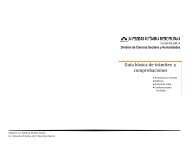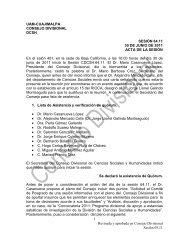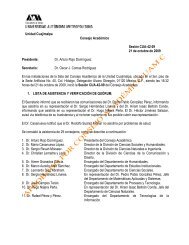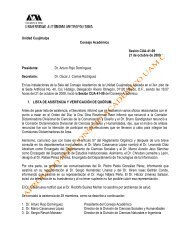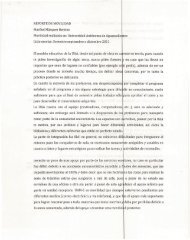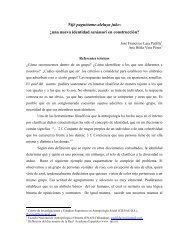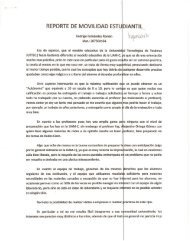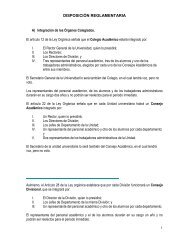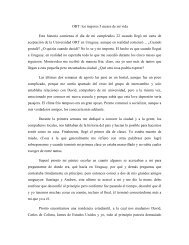A novel 8.7 kDa protease inhibitor from chan seeds (Hyptis ... - UAM
A novel 8.7 kDa protease inhibitor from chan seeds (Hyptis ... - UAM
A novel 8.7 kDa protease inhibitor from chan seeds (Hyptis ... - UAM
You also want an ePaper? Increase the reach of your titles
YUMPU automatically turns print PDFs into web optimized ePapers that Google loves.
C. Aguirre et al. / Comparative Biochemistry and Physiology Part B 138 (2004) 81–89<br />
83<br />
2.1.4. Reverse-phase HPLC<br />
A concentrated <strong>inhibitor</strong> sample <strong>from</strong> the pooled<br />
ion-ex<strong>chan</strong>ge chromatography (100 ml) after dialysis,<br />
was separated by a reverse-phase Vydac C 18<br />
HPLC column (22.5 mm ID=250 mm length and<br />
10 mm particle size), with a gradient of 0–80%<br />
(by vol.) acetonitrile in water (Fig. 4). Peak<br />
fractions were frozen and lyophilized to remove<br />
the acetonitrile. Fractions were evaluated by electrophoresis<br />
(Fig. 5), and those containing a single<br />
band were used for protein characterization.<br />
2.1.5. Protein determination<br />
Protein concentration was determined by the<br />
Bradford protein assay (Bradford, 1976). Bovine<br />
serum albumin (BSA) was used as standard.<br />
2.2. Characterization<br />
2.2.1. Molecular mass determination<br />
Molecular mass was determined by sodium<br />
dodecyl sulfate- polyacrylamide gel electrophoresis<br />
(SDS-PAGE) using a 13% separating gel, following<br />
procedure Schagger ¨ and von Jagow (1987).<br />
Globin (16 949 Da), Globin IqII (14 404 Da),<br />
Globin IqIII (10 700 Da), Globin I (8159 Da),<br />
Globin II (6214 Da) and Globin III (2512 Da),<br />
were used as molecular mass markers.<br />
2.2.2. Isoelectric point<br />
Isoelectric focusing (IEF) was performed at RT<br />
in a Pharmacia LKB electrophoresis PhastSystem<br />
using a Phastgel 3-9.<br />
2.2.3. Stability<br />
Stability of the <strong>inhibitor</strong> was evaluated by<br />
exposing the sample for 60 min at temperatures<br />
ranging <strong>from</strong> 4 to 94 8C, at five different pH<br />
values, <strong>from</strong> pH 3 to 10.7. The <strong>inhibitor</strong> (0.02<br />
mg) was dissolved in 1 ml of the appropriate<br />
buffer (0.025 M) solution. Buffers included citrate<br />
solution pH 3 and pH 5, phosphate solution pH 7<br />
and carbonate solutions pH 9.2 and pH 10.7. For<br />
residual trypsin <strong>inhibitor</strong>y activity at the end of<br />
the thermal treatment, the solution was cooled in<br />
an ice bath and the activity determined at RT in<br />
0.15 M Tris–HCl, CaCl 2, 0.05 M, pH 8.1 buffer<br />
solution, using bovine trypsin and BAEE as substrate<br />
to monitor the activity (Schwertz and Takenaka,<br />
1955).<br />
2.2.4. N-terminal sequence determination<br />
The N-terminal sequence of the purified protein<br />
was determined using repeated cycles of Edman<br />
degradation. Analysis was performed in an automatic<br />
sequencer (Beckman–Porton Protein<br />
sequencer, model LF 3000).<br />
2.2.5. Circular dichroism spectroscopy analysis<br />
This analysis was performed using a JASCO J-<br />
715 spectropolarimeter calibrated with (q)10-<br />
camphorsulfonic acid (Hennessey and Johnson,<br />
1982). Samples were dialyzed overnight against<br />
water, and spectra were obtained in a quartz cell<br />
of 1 mm pathlength at a protein concentration of<br />
0.1 mgyml. Circular dichroism spectra were deconvoluted<br />
in the DichroWeb server (Lobley et al.,<br />
2002) with four different methods: k2d, Selcon,<br />
Contin and CDSSTR (Andrade et al., 1993; Sreerama<br />
and Woody, 2000). The former is a neural<br />
network algorithm that interprets the region <strong>from</strong><br />
200 to 240 nm of CD spectra in terms of three<br />
different secondary structure contributors: a-helix,<br />
b-strand and others. The latter methods use a<br />
broader region of the spectra (185–240 nm) and<br />
estimates the a-helix, b-strand, turn and irregular<br />
fractions of secondary structure; also, they can use<br />
different sets of CD spectra as reference. In this<br />
work we used sets 3, 4, 6 and 7 <strong>from</strong> the<br />
DichroWeb server and results were averaged and<br />
are presented in Table 3.<br />
2.3. Extraction of larval enzymes<br />
Proteolytic enzymes were extracted <strong>from</strong> third<br />
instar larvae for the insects: P. truncatus (Horn)<br />
(Coleoptera: Bostrichidae), Sitotroga cerealella<br />
(Olivier) (Lepidoptera: Gelechiidae), Tribolium<br />
castaneum (Herbst) (Coleoptera: Tenebrionidae),<br />
Callosobruchus maculatus (Fabricius) (Coleoptera:<br />
Bruchidae), Acanthoscelides obtectus (Say)<br />
(Coleoptera: Bruchidae) and Sitophilus zeamais<br />
(Motschulsky) (Coleoptera: Curculionidae). For<br />
Manduca sexta (Linnaeus) (Lepidoptera: Sphingidae),<br />
fifth instar larvae were used. The extraction<br />
was done according to the method described by<br />
Valdes-Rodrıguez ´ ´ et al. (1993), using crude<br />
extracts.<br />
2.3.1. Zymograms<br />
For the assay of <strong>protease</strong> <strong>inhibitor</strong> activity in<br />
polyacrylamide gel electrophoresis, we followed<br />
the method described by Garcıa-Carreno ´ ˜ et al.



